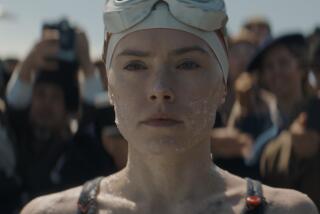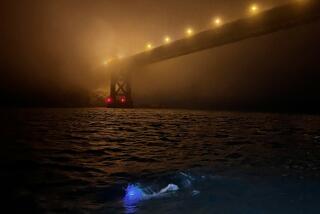Abby Sunderland makes her own sails pitch
Reporting from Aboard Wild Eyes — Abby Sunderland is bundled in foul-weather gear at the tiller of the 40-foot racing yacht Wild Eyes as it grudgingly navigates chaotic swells on a northward trudge against a bone-chilling head wind along the Baja California coast.
But as long hours pass into even worse conditions, there are no complaints from the 16-year-old from Thousand Oaks, who knows this is paradise compared with what she’ll soon face much farther from home and in far more turbulent seas.
If this has a familiar tone, it’s understandable. Abby’s brother Zac, 17, in July became the youngest American sailor to circle the globe alone. His highly publicized odyssey featured adventures in exotic ports but also merciless gales, a run-in with pirates and a near-collision with a gargantuan freighter near the Panama Canal.
Now it’s Abby’s turn aboard an orange-hulled vessel she’s delivering from Ensenada to Marina del Rey so it can be outfitted for her voyage around the world.
Abby will depart this month on what is expected to be a five-month excursion more ambitious than Zac’s. She’ll strive to become the youngest person to make the trip alone, nonstop and unassisted.
She’ll carry all provisions -- including freeze-dried food and a water desalination device -- and cannot make landfall or accept assistance, beyond advice, once she’s underway.
Whereas Zac traveled in higher latitudes in mostly warm climates, Abby will venture offshore and sail down the Pacific, round South America and treacherous Cape Horn, then continue east below the populated continents in the wind-swept and turbulent Southern Ocean -- a direct but dangerous route around the world.
The journey is a realization of a dream she first entertained when she was 13 -- before her brother sold their parents on his idea to see the world aboard the 36-foot Intrepid.
“My parents didn’t take me seriously back then,” Abby says. “They needed to be sure that I was sure I wanted to do this.”
The Sunderland parents anticipate another round of criticism anyway. They faced disapproval about Zac’s voyage, and they expect the volume to be louder about an even younger child -- a girl, no less -- attempting something so dangerous.
Laurence Sunderland, 46, a shipwright and lifelong sailor, chooses to ignore the criticism but acknowledges the risk.
“I do grapple with it,” he concedes as Wild Eyes, a light and speedy craft that craves a tail wind, struggles to make 5 knots. “Because she’s a girl, it’s harder for me to acknowledge her desires and have all this happen.
“But she’s ready for it from the standpoint of sailing ability, and emotionally I believe she’s ready to tackle this head-on . . . I’ve tried to scare her away from it by showing her some ugly stuff that happens down there, and with everything I push in her face she just gets more encouraged.”
Abby, the second-oldest of seven Sunderland children (Marianne Sunderland is pregnant with No. 8), does not appear the part of fearless adventurer: She’s of ordinary build and acts like a typical high school junior. (Home-schooled, she says she’ll take textbooks along, but so did her brother, who never found time to get to them.)
However, Abby points out that the diminutive Ellen MacArthur once sailed a high-speed trimaran around the world in 71 days. Dawn Riley, a renowned sailor and racer, was another early inspiration.
“A lot of people see that I’m a girl and don’t support me as much as they did my brother,” Abby says. “It’s understandable, and I do acknowledge that I kind of have disadvantages, but I’m just as capable as Zac is.”
Australia’s Jessica Watson, also 16 but a few months older than Abby, is more than 6,000 miles into her attempt to sail around the world nonstop and unassisted.
Before she left in mid-October aboard a 34-foot pink sailboat, Watson’s parents endured criticism so unrelenting her “mum” spoke out against what she called gender-driven bias.
The opposition escalated after Watson collided with a Chinese freighter and narrowly avoided tragedy -- her yacht lost its mast in the dark -- during a sea trial before her journey.
After a preliminary maritime agency report found that Watson was asleep and did not take adequate steps to avoid the collision, Queensland Premier Anna Bligh, who had backed Watson’s campaign, expressed second thoughts. A children’s commission opposed the adventure, and a Yachting Australia executive denounced age-related sailing records.
Feelings throughout the international sailing community appear mixed in regard to the age issue surrounding Watson and Sunderland.
Don McIntyre, a renowned Australian adventurer, supports both campaigns, saying children “have lost the art of dreaming.”
“You must come from a very special background to have the strength of character to believe in yourself to actually pull it off,” McIntyre says. “I know Jessica and she has the correct head space. I don’t know Abby, but it is pretty obvious that she has not been playing with Barbie dolls for the past 16 years.”
Karen Thorndike, who in 1998 became the first American woman to sail around the world alone, implied 16 is too young for a nonstop Southern Ocean voyage.
“That’s a whole different sort of animal,” says Thorndike, who was 63 when she began what she thought would be a nonstop trip but required three years and extended layovers before she completed her odyssey.
“Part of me says when you’re young, you’re fearless and somehow God watches over you,” Thorndike adds. “But there are a lot of things you just don’t anticipate, and you have absolutely no relief from just the nonstop effort of being on watch -- and you are on watch day and night.”
Watson and Sunderland plan to round the Great Capes at the bottom of South America, Africa, Australia and New Zealand, as Thorndike did. The greatest challenge might lie below Cape Horn at South America’s tip, where gale-force winds and raging currents, along with enormous shifting waves, have capsized vessels small and large.
“I’ve told Abigail, ‘You will see 60 knots [just shy of 70 mph] of wind down there, probably on more than one occasion,’ ” Laurence Sunderland says of his daughter’s route. “I have no doubt in my mind that this boat is going to get totally knocked around out there.”
Yoh Aoki, a Japanese sailor who circumnavigated the globe over three years in a 21-foot homemade boat, calls his 1972 Cape Horn passage miraculous.
A wave he recalls as being about 100 feet high turned his vessel upside down before another wave somehow righted the craft. “The upside-down boat had started sinking because a lot of water came into the cabin,” Aoki recalls.
Abby is unfazed, but as Wild Eyes travels under auto-pilot she reflects on what she’ll miss: Friends, home-cooked meals and a comfortable bed come to mind. So does her 5-year-old sister Katherine, with whom she shares a bedroom and holds a close bond.
When Abby returns from a trip of any length, Katherine invariably asks, “Were you sailing around the world?”
Lately, Abby has been with Laurence and Zac trying to get Wild Eyes from the East Coast to Marina del Rey. The boat has already endured Cape Horn’s foul moods once -- on a trip around the world under a previous owner.
With the help of the lone major sponsor, Shoe City, the middle-class Sunderlands purchased the vessel for $90,000 and sailed it from Rhode Island to Florida, reaching 24 knots -- about 28 mph -- along the way.
The boat was shipped from Florida to Ensenada, where the task of delivering it home began. The route, uphill against wind and current, is monotonously slow to begin with -- and it does not help that Abby and Laurence have allowed a reporter, a photographer and a videographer aboard a yacht designed for single-handed racing.
Nor is it beneficial that Wild Eyes, in the dark wee-morning hours, has plowed over an invisible and enormous paddy of kelp, which has become hopelessly tangled on the boat’s keel and rudder.
The kelp isn’t the type of obstacle Abby will face on the high seas, but she is growing short on patience, so a request is made for Zac and a friend, who are aboard a companion sailboat, to tow Wild Eyes the short remainder of what turns out to be a 17-hour voyage to San Diego.
With both vessels secure alongside the U.S. Customs dock, Zac confronts Abby, poking his finger playfully, and accuses her of sleeping.
“I did not sleep -- you’re the one who slept,” she counters, saying she ventured below only to adjust the auto-pilot or talk on the radio.
The exchange is playful, but Zac knows that how Abby handles sleep deprivation will play a major role in her success or failure.
“There were times when I didn’t sleep for three days,” he says. “And if you’re in a storm and need to hand-steer, there’s no one out there to take your place.”
Zac then dons a mask and dives in to knife the kelp from Wild Eyes’ keel -- a task that, for reasons of principle, he probably should have left to his sister.
More to Read
Sign up for The Wild
We’ll help you find the best places to hike, bike and run, as well as the perfect silent spots for meditation and yoga.
You may occasionally receive promotional content from the Los Angeles Times.






